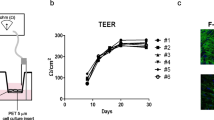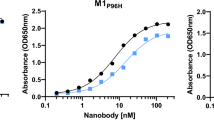Abstract
Blood–brain barrier (BBB) is specialized to limit brain drug delivery. Cross-reacting material 197 (CRM197), a non-toxic mutant of diphtheria toxin, could act as a diphtheria toxin receptor-specific carrier protein and deliver drugs across the BBB. CRM197 has previously been shown to inhibit phospatidyl-3-inositol-kinase (PI3K)/Akt signaling. Other studies have demonstrated a link between PI3K/Akt signaling and forkhead transcription factors in endothelial cells. We therefore investigated the effects and mechanisms underlying the potential of CRM197, not only as a carrier protein for targeted drug delivery to the brain, but also for inducing signaling to affect endocytosis in endothelial cells. The hCMEC/D3 cell line had been used to establish a BBB in vitro model; the transport efficiency of CRM197 was analyzed both by association and transcytosis experiments. CRM197 was shown to prefer apical-to-basal transcytosis, which involved the caveolae-mediated pathway. The uptake of CRM197 conjugates by endothelial cells reached equilibrium after 60 min of treatment. The caveolin-1 mRNA and protein expression levels were significantly increased by CRM197. The up-regulation of caveolin-1 may be mediated by CRM197 via a PI3K/Akt dependent pathway and reduction of the phospho-FOXO1A (forkhead box O) transcription factor. Our results indicate that carrier protein CRM197-mediated delivery across the BBB is involved in the induction of FOXO1A transcriptional activity and upregulation of caveolin-1 expression.






Similar content being viewed by others
References
Abbott NJ, Rönnbäck L, Hansson E (2006) Astrocyte-endothelial interactions at the blood-brain barrier. Nat Rev Neurosci 7(1):41–53
Brunet A, Bonni A, Zigmond MJ, Lin MZ, Juo P, Hu LS, Anderson MJ, Arden KC, Blenis J, Greenberg ME (1999) Akt promotes cell survival by phosphorylating and inhibiting a Forkhead transcription factor. Cell 96:857–868
Buzzi S, Rubboli D, Buzzi G, Buzzi AM, Morisi C, Pironi F (2004) CRM197 (nontoxic diphtheria toxin): effects on advanced cancer patients. Cancer Immunol Immunother 53(11):1041–1048
Candela P, Gosselet F, Miller F, Buee-Scherrer V, Torpier G, Cecchelli R, Fenart L (2008) Physiological pathway for low-density lipoproteins across the blood-brain barrier: transcytosis through brain capillary endothelial cells in vitro. Endothelium 15(5–6):254–264
Chang T, Neville DM Jr (1978) Demonstration of diphtheria toxin receptors on surface membranes from both toxin-sensitive and toxin-resistant species. J Biol Chem 253(19):6866–6871
Dehouck B, Fenart L, Dehouck MP, Pierce A, Torpier G, Cecchelli R (1997) A new function for the LDL receptor: transcytosis of LDL across the blood–brain barrier. J Cell Biol 138(4):877–889
Deli MA, Abrahám CS, Kataoka Y, Niwa M (2005) Permeability studies on in vitro blood–brain barrier models: physiology, pathology, and pharmacology. Cell Mol Neurobiol 25(1):59–127
Demeule M, Poirier J, Jodoin J, Bertrand Y, Desrosiers RR, Dagenais C, Nguyen T, Lanthier J, Gabathuler R, Kennard M, Jefferies WA, Karkan D, Tsai S, Fenart L, Cecchelli R, Béliveau R (2002) High transcytosis of melanotransferrin (P97) across the blood–brain barrier. J Neurochem 83:924–933
Dorland RB, Middlebrook JL, Leppla SH (1979) Receptor-mediated internalization and degradation of diphtheria toxin by monkey kidney cells. J Biol chem 254(22):11337–11342
Drab M, Verkade P, Elger M, Kasper M, Lohn M, Lauterbach B, Menne J, Lindschau C, Mende F, Luft FC, Schedl A, Haller H, Kurzchalia TV (2001) Loss of caveolae, vascular dysfunction, and pulmonary defects in caveolin-1 gene-disrupted mice. Science 293:2449–2452
Farquhar M, Palade G (1963) Junctional complexes in various epithelia. J Cell Biol 17:375–412
Furuyama T, Nakazawa T, Nakano I, Mori N (2000) Identification of the differential distribution patterns of mRNAs and consensus binding sequences for mouse DAF-16 homologues. Biochem J 349:629–634
Gaillard PJ, de Boer AG (2006) A novel opportunity for targeted drug delivery to the brain. J Control Release 116(2):e60–e62
Gaillard PJ, Brink A, Boer de AG (2004) WO2004069870
Gaillard PJ, Brink A, de Boer AG (2005a) Diphtheria toxin receptor-targeted brain drug delivery. Int Congres Series 1277:185–198
Gaillard PJ, Visser CC, de Boer AG (2005b) Targeted delivery across the blood–brain barrier. Exp Opin Drug Deliv 2(2):299–309
Ikezu T, Ueda H, Trapp BD, Nishiyama K, Sha JF, Volonte D, Galbiati F, Byrd AL, Bassell G, Serizawa H, Lane WS, Lisanti MP, Okamoto T (1998) Affinity-purification and characterization of caveolins from the brain: differential expression of caveolin-1, -2, and -3 in brain endothelial and astroglial cell types. Brain Res 804:177–192
Jones AR, Shusta EV (2007) Blood–brain barrier transport of therapeutics via receptor-mediation. Pharm Res 24(9):1759–1771
Kageyama T, Ohishi M, Miyamoto S, Mizushima H, Iwamoto R, Mekada E (2007) Diphtheria toxin mutant CRM197 possesses weak EF2-ADP-ribosyl activity that potentiates its anti-tumorigenic activity. J Biochem 142:95–104
Lee HY, You HJ, Won JY, Youn SW, Cho HJ, Park KW, Park WY, Seo JS, Park YB, Walsh K, Oh BH, Kim HS (2008) Forkhead factor, FOXO3a, induces apoptosis of endothelial cells through activation of matrix metalloproteinases. Arterioscler Thromb Vasc Biol 28:302–308
Li S, Couet J, Lisanti MP (1996) Src tyrosine kinases, Gα subunits, and H-Ras share a common membrane-anchored scaffolding protein, caveolin. Caveolin binding negatively regulates the auto-activation of Src tyrosine kinases. J Biol Chem 271:29182–29190
Lu ML, Schneider MC, Zheng YX, Zhang XB, Richie JP (2001) Caveolin-1 interacts with androgen receptor. A positive modulator of androgen receptor mediated transactivation. J Biol Chem 276(16):13442–13451
Majno G, Palade G (1961) Studies on inflammation. 1. The effect of histamine and serotonin on vascular permeability: an electron microscopic study. J Biophys Biochem Cytol 11:571–605
Mishima K, Higashiyama S, Asai A, Yamaoka K, Nagashima Y, Taniguchi N, Kitanaka C, Kirino T, Kuchino Y (1998) Heparinbinding epidermal growth factor-like growth factor stimulates mitogenic signaling and is highly expressed in human malignant gliomas. Acta Neuropathol 96(4):322–328
Nag S, Venugopalan R, Stewart DJ (2007) Increased caveolin-1 expression precedes decreased expression of occludin and claudin-5 during blood-brain barrier breakdown. Acta Neuropathol 114:459–469
Predescu D, Palade GE (1993) Plasmalemmal vesicles represent the large pore system of continuous microvascular endothelium. Am J Physiol 265(2 Pt 2):H725–H733
Raab G, Klagsbrun M (1997) Heparin-binding EGF-like growth factor. Biochim Biophys Acta 1333(3):F179–F199
Razani B, Lisanti MP (2001) Two distinct caveolin-1 domains mediate the functional interaction of caveolin-1 with protein kinase A. Am J Physiol Cell Physiol 281:C1241–C1250
Razani B, Engelman JA, Wang XB, Schubert W, Zhang XL, Marks CB, Macaluso F, Russell RG, Li M, Pestell RG, Di Vizio D, Hou H Jr, Kneitz B, Lagaud G, Christ GJ, Edelmann W, Lisanti MP (2001) Caveolin-1 null mice are viable but show evidence of hyperproliferative and vascular abnormalities. J Biol Chem 276:38121–38138
Schnitzer JE, Oh P, Pinney E, Allard J (1994) Filipin-sensitive caveolae-mediated transport in endothelium: reduced transcytosis, scavenger endocytosis, and capillary permeability of select macromolecules. J Cell Biol 127(5):1217–1232
Sigurdardottir ST, Davidsdottir K, Arason VA, Jonsdottir O, Laudat F, Gruber WC, Jonsdottir I (2008) Safety and immunogenicity of CRM197-conjugated pneumococcal-meningococcal C combination vaccine (9vPnC-MnCC) whether given in two or three primary doses. Vaccine 26:4178–4186
Tanaka N, Sasahara M, Ohno M, Higashiyama S, Hayase Y, Shimada M (1999) Heparinbinding epidermal growth factor-like growth factor mRNA expression in neonatal rat brain with hypoxic/ischemic injury. Brain Res 827(1–2):130–138
Tang ED, Nunez G, Barr FG, Guan KL (1999) Negative regulation of the forkhead transcription factor FKHR by Akt. J Biol Chem 274:16741–16746
van den Heuvel AP, Schulze A, Burgering BM (2005) Direct control of caveolin-1 expression by FOXO transcription factors. J Biochem 385:795–802
Virgintino D, Robertson D, Errede M, Benagiano V, Tauer U, Roncali L, Bertossi M (2002) Expression of caveolin-1 in human brain microvessels. Neuroscience 115:145–152
Visser CC, Stevanović S, Voorwinden LH, Gaillard PJ, Crommelin DJ, Danhof M, De Boer AG (2004) Validation of the transferrin receptor for drug targeting to brain capillary endothelial cells in vitro. J Drug Target 12(3):145–150
Wu D, Terrian DM (2002) Regulation of caveolin-1 expression and secretion by a protein kinase cepsilon signaling pathway in human prostate cancer cells. J Biol Chem 277:40449–40455
Xia CY, Zhang Z, Xue YX, Wang P, Liu YH (2009) Mechanisms of the increase in the permeability of the blood-tumor barrier obtained by combining low-frequency ultrasound irradiation with small-dose bradykinin. J Neurooncol 94(1):41–50
Xie Z, Zeng X, Waldman T, Glazer RI (2003) Transformation of mammary epithelial cells by 3-phosphoinositide-dependent protein kinase-1 activates beta-catenin and c-Myc, and down-regulates caveolin-1. Cancer Res 63:5370–5375
Yamamoto H, Komekado H, Kikuchi A (2006) Caveolin is necessary for Wnt-3a-dependent internalization of LRP6 and accumulation of b-catenin. Dev Cell 11:213–223
Zhao YY, Gao XP, Zhao YD, Mirza MK, Frey RS, Kalinichenko VV, Wang IC, Costa RH, Malik AB (2006) Endothelial cell-restricted disruption of FoxM1 impairs endothelial repair following LPS-induced vascular injury. J Clin Invest 116:2333–2343
Acknowledgments
hCMEC/D3 cells were kindly provided by Prof. Dr. Pierre-Olivier Couraud (INSERM U567, Paris, France). This work is supported by grants from the Natural Science Foundation of China (No. 30670723, 30700861, 30800451, 30872656, 30973079), Natural Science Foundation of Liaoning Province in China (No. 20052102, 20082102), Science and Technology Plan Project of Educational Department of Liaoning Province (No. 2008850), and Shenyang Science and Technology Plan Projects (No. 1091175-1-01, 1081266-9-00).
Author information
Authors and Affiliations
Corresponding author
Additional information
Ping Wang and Yixue Xue have contributed equally to this work.
Rights and permissions
About this article
Cite this article
Wang, P., Xue, Y., Shang, X. et al. Diphtheria Toxin Mutant CRM197-Mediated Transcytosis across Blood–Brain Barrier In Vitro. Cell Mol Neurobiol 30, 717–725 (2010). https://doi.org/10.1007/s10571-010-9496-x
Received:
Accepted:
Published:
Issue Date:
DOI: https://doi.org/10.1007/s10571-010-9496-x




